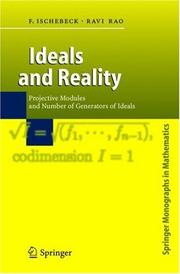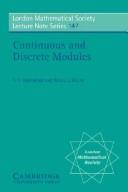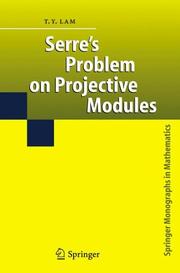| Listing 1 - 4 of 4 |
Sort by
|

ISBN: 1280312262 9786610312269 3540263705 3540230327 Year: 2005 Publisher: Berlin ; New York : Springer,
Abstract | Keywords | Export | Availability | Bookmark
 Loading...
Loading...Choose an application
- Reference Manager
- EndNote
- RefWorks (Direct export to RefWorks)
This monograph tells the story of a philosophy of J-P. Serre and his vision of relating that philosophy to problems in affine algebraic geometry. It gives a lucid presentation of the Quillen-Suslin theorem settling Serre's conjecture. The central topic of the book is the question of whether a curve in $n$-space is as a set an intersection of $(n-1)$ hypersurfaces, depicted by the central theorems of Ferrand, Szpiro, Cowsik-Nori, Mohan Kumar, Boratýnski. The book gives a comprehensive introduction to basic commutative algebra, together with the related methods from homological algebra, which will enable students who know only the fundamentals of algebra to enjoy the power of using these tools. At the same time, it also serves as a valuable reference for the research specialist and as potential course material, because the authors present, for the first time in book form, an approach here that is an intermix of classical algebraic K-theory and complete intersection techniques, making connections with the famous results of Forster-Swan and Eisenbud-Evans. A study of projective modules and their connections with topological vector bundles in a form due to Vaserstein is included. Important subsidiary results appear in the copious exercises. Even this advanced material, presented comprehensively, keeps in mind the young student as potential reader besides the specialists of the subject.
Projective modules (Algebra) --- Ideals (Algebra) --- Commutative rings. --- Generators. --- Rings (Algebra) --- Generators of ideals (Algebra) --- Modules (Algebra)

ISBN: 1139884611 1107366577 1107371260 1107361664 1107370310 1299404332 1107364116 0511892527 0511600690 9781107361669 9780511892523 0521399750 9780521399753 9780511600692 Year: 1990 Publisher: Cambridge ; New York : Cambridge University Press,
Abstract | Keywords | Export | Availability | Bookmark
 Loading...
Loading...Choose an application
- Reference Manager
- EndNote
- RefWorks (Direct export to RefWorks)
Continuous and discrete modules are, essentially, generalizations of infective and projective modules respectively. Continuous modules provide an appropriate setting for decomposition theory of von Neumann algebras and have important applications to C*-algebras. Discrete modules constitute a dual concept and are related to number theory and algebraic geometry: they possess perfect decomposition properties. The advantage of both types of module is that the Krull-Schmidt theorem can be applied, in part, to them. The authors present here a complete account of the subject and at the same time give a unified picture of the theory. The treatment is essentially self-contained, with background facts being summarized in the first chapter. This book will be useful therefore either to individuals beginning research, or the more experienced worker in algebra and representation theory.
Injective modules (Algebra) --- Projective modules (Algebra) --- Representations of rings (Algebra) --- Decomposition (Mathematics) --- Mathematics --- Probabilities --- Rings (Algebra) --- Modules (Algebra)

ISSN: 14397382 ISBN: 9783540345756 3540233172 9783540233176 3642062350 9786612823770 1282823779 3540345752 Year: 2006 Publisher: Berlin: Springer,
Abstract | Keywords | Export | Availability | Bookmark
 Loading...
Loading...Choose an application
- Reference Manager
- EndNote
- RefWorks (Direct export to RefWorks)
Revised reissue of author's "Serre's conjecture," 1978.
Mathematics. --- Commutative Rings and Algebras. --- Associative Rings and Algebras. --- Algebra. --- Mathématiques --- Algèbre --- Projective modules (Algebra) --- Geometry, Algebraic. --- Commutative algebra. --- Projective modules (Algebra). --- Commutative algebra --- Geometry, Algebraic --- Mathematics --- Physical Sciences & Mathematics --- Algebra --- Algebraic geometry --- Associative rings. --- Rings (Algebra). --- Commutative rings. --- Rings (Algebra) --- Algebraic rings --- Ring theory --- Algebraic fields --- Math --- Science --- Geometry --- Modules (Algebra) --- Mathematical analysis

ISBN: 9783764375720 3764375728 9786610627738 1280627735 3764375736 Year: 2006 Publisher: Basel ; Boston : Birkhauser Verlag,
Abstract | Keywords | Export | Availability | Bookmark
 Loading...
Loading...Choose an application
- Reference Manager
- EndNote
- RefWorks (Direct export to RefWorks)
Extending modules are generalizations of injective modules and, dually, lifting modules generalize projective supplemented modules. There is a certain asymmetry in this duality. While the theory of extending modules is well documented in monographs and text books, the purpose of our monograph is to provide a thorough study of supplements and projectivity conditions needed to investigate classes of modules related to lifting modules. The text begins with an introduction to small submodules, the radical, variations on projectivity, and hollow dimension. The subsequent chapters consider preradicals and torsion theories (in particular related to small modules), decompositions of modules (including the exchange property and local semi-T-nilpotency), supplements in modules (with specific emphasis on semilocal endomorphism rings), finishing with a long chapter on lifting modules, leading up their use in the theory of perfect rings, Harada rings, and quasi-Frobenius rings. Most of the material in the monograph appears in book form for the first time. The main text is augmented by a plentiful supply of exercises together with comments on further related material and on how the theory has evolved.
Modules (Algebra) --- Moduli theory. --- Projective modules (Algebra) --- Ideals (Algebra) --- Modules (Algèbre) --- Variétés topologiques à 4 dimensions --- Idéaux (Algèbre) --- Ideals (Algebra). --- Modules (Algebra). --- Projective modules (Algebra). --- Moduli theory --- Mathematics --- Physical Sciences & Mathematics --- Algebra --- Algebraic ideals --- Theory of moduli --- Finite number systems --- Modular systems (Algebra) --- Mathematics. --- Algebra. --- Mathematical analysis --- Math --- Science --- Algebraic fields --- Rings (Algebra) --- Analytic spaces --- Functions of several complex variables --- Geometry, Algebraic --- Finite groups
| Listing 1 - 4 of 4 |
Sort by
|

 Search
Search Feedback
Feedback About UniCat
About UniCat  Help
Help News
News